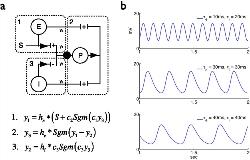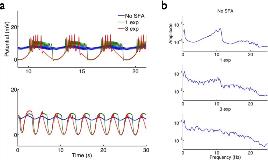SPIKE RATE ADAPTATION FACILITATES SLOW OSCILLATIONS IN A MODEL OF EEG SIGNALS
Abstract number :
2.398
Submission category :
Year :
2014
Submission ID :
1868950
Source :
www.aesnet.org
Presentation date :
12/6/2014 12:00:00 AM
Published date :
Dec 4, 2014, 06:00 AM
Authors :
Brian Lundstrom
Rationale: Slow oscillations (<1 Hz) of EEG are a prominent feature of physiological recordings and are thought to be an intrinsic property of the cortex [1], although their function remains uncertain. Evidence from human EEG show that epileptiform discharges are phase-locked to infra-slow oscillations (~0.01-0.3Hz) [2]. Slow adaptation currents, which underlie neuronal firing rate adaptation, have been implicated in the maintenance of slow oscillations [3]. Here, the goal was to add rate adaptation in a standard neural network of EEG oscillation, and test the hypothesis that rate adaptation affects slow oscillations. Methods: The Jansen and Rit neural mass model [4] of EEG dynamics simulates a cortical column of three neural populations: pyramidal neurons and excitatory and inhibitory interneurons (Fig 1). The input to the model represents stimuli from other cortical areas and the thalamus. This mathematical network model, which does not include rate adaptation, was implemented. Spike rate adaptation was added to the network via a filter equation acting at the spike generating mechanism of the pyramidal neuron, via a method recent developed [5]. Results: Rate adaptation was added to the Jansen and Rit model of EEG signals and led to an increased mean of the model output, as rate adaptation affected the inhibitory interneurons more than the excitatory interneurons [5]. With a slow 0.3 Hz sinusoidal input, rate adaptation facilitated responses at slow frequencies (Fig 2). Multiple time scale rate adaptation flattened the output power spectrum, minimizing the effect of intrinsic network oscillations. Conclusions: Slow oscillations are facilitated and become more prominent when rate adaptation is added to the network. Given prior work relating slow oscillations to epileptiform discharges (EDs) [2], these results support a relationship between rate adaptation and EDs. Given the prevalence of rate adaptation in healthy cortex, the fact that anti-epileptic drugs such as lacosamide appear to promote rate adaptation, and the association between slow oscillations and epileptic activity, rate adaptation may provide a compensatory response of cortex to epileptic activity. Methods for understanding and assessing rate adaptation may have significant clinical relevance. References: [1] Steriade M, Contreras D, Curró Dossi R, Nuñez A. J Neurosci. 1993 Aug;13(8):3284-99. [2] Vanhatalo S, Palva JM, Holmes MD, Miller J JW,Voipio J, Kaila K. Proc Natl Acad Sci U S A. 2004 Apr 6;101(14):5053-7. [3] Destexhe A, Hughes SW, Rudolph M, Crunelli V. Trends Neurosci. 2007 30:334-342. [4] Jansen BH, Rit VG. Biol Cybern. 1995 Sep;73(4):357-66. [5] Lundstrom BN. J Comput Neurosci. 2014 In press.

